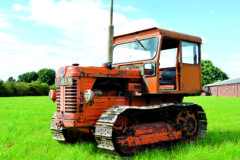Stationary engine survivors
Posted by Chris Graham on 13th October 2020
Eric Brain reports on a couple of interesting stationary engine survivors that came to light in Spain recently.

Sadly, having been buried for 45 years, the 3hp Victoria engine is too corroded and incomplete to restore. It makes an interesting patio ornament, though!
Stationary engines – and the engine-collecting scene generally – don’t seems to have fired the imagination of many enthusiasts in Spain, unlike the situation in Holland, France, Ireland and Germany, where the hobby has a strong following.
Nevertheless, Stationary Engine magazine was delighted to hear from one of its readers recently, via Facebook, regarding a pair of recently acquired, Bristol Wagon & Carriage Works Co engines. Rescued by a family living near Vegadeo, in northern Spain, the engines are owned by Rubén and Sonia Garcia Gonzalez, and their son, Martin. Through the miracle of modern technology – known as an online translation site, and following a series of emails back and forth to Sonia, I’ve been able to piece together the following about these two engines.
The 3hp engine
The first engine is a very sadly decomposed 3hp Victoria, which a neighbour told Sonia’s father he’d found after it had been buried for 45 years following repairs he’d made to his house. Apparently, the couple bought an old, stone-built house with land and stables and, in one of those, there was a lot of junk including the stationary engine.

Rubén and Martin look pleased with the day’s engine collecting. There’s also a Deutz lurking on that trailer.
While the house was being repaired, their children played with the engine and managed to dismantle it. Then, when the house repair was finished, the couple dug a hole and buried the engine, covering it other debris on top. Then, wind the clock forward 45 years later, and a farmer ploughing the same land hit something solid while preparing the area for some livestock.
A bit more diffing revealed part of a curved, iron wheel. Word of the find spread quickly, and generated plenty of local interest local intrigue , so it was decided to unearthed it.
After some time had passed – and by chance – the owner told Sonia’s father that he was going to sell it for scrap metal. So father then told Ruben who was able to buy the remains for €50. A bargain! However, the engine was incomplete; all the ancilliaries were missing and the water jacket had totally disintegrated. However, the flywheels still revolved, which was amazing, although restoration was judged to be impossible. So the remains make an interesting garden ornament!
A restorable 5hp Victoria
However, better news! The family has – after looking for some years – now acquired another Victoria to add to the small collection. It’s this, 5hp one that had aroused interest on the Facebook Stationary Engine Enthusiasts site!
Up to this point, it was never known that Victorias were sold to Spain, so it may have been just a handful through a little-known local agent.

The 5hp Victoria in ‘as found’ condition.

The cast-in magneto bracket, stub pipe for the cylinder oiler and the home-made mod to hold the carburettor bowl in place, can all be clearly seen.
Restoration has now begun in earnest, but it appears that the engine lacks the serial plate, the Bosch 22 magneto, the oil dripper and the knob where it’s decompressed when starting. However, the rest of the mechanism inside the casing is intact. At first sight in a photograph, it was apparent that a crude attempt had been made to reunite the carburettor float chamber and body. This very fine and easily-damaged thread joining the two components has been the subject of much discussion in these pages over recent years.

The simple but effective modification to the carburettor float chamber.
Roughly-dated
I was able to roughly date the engine although, unusually, there is no serial number stamped on the end of the crank – just the part number, A198. However, both the crank ends have the key identification numbers as stamped by the fitter in Bristol over a century ago.

No serial number on the crankshaft end; just the part number and fitter’s stamp to identify the key.
Using Tim Macaire’s Victoria booklet as a guide, the cam-drive trip to the magneto appears to be the style fitted for just a short period around 1912.

This magneto trip-drive cam appears to be of the late 1911 to 1912 pattern.

Diagram from the ‘Victoria’ book, showing the cam-trip strikers of the period. (Courtesy: Tim Macaire)
In conjunction with that fact, the sump has the drain hole drilled, though blocked with piece of wood (an universal, ‘farmer’s method’ it seems, whether Spanish or English!) and, though missing, there’s evidence of a cylinder oiler, a feature which was discontinued in 1913 and the holes left blank/undrilled. The magneto bracket is also cast into the front of the crankcase, not bolted on.
Cracked water jacket
Rubén didn’t think of taking good photos before dismantling the engine, but he told me that the cylinder has some cracks in the water-jacket due to frost damage; also, the previous owner “hit it hard with a tractor without realising it, and made more cracks!”

Most Victorias suffered from cracks due to frost damage; this one is no exception, despite being found in Spain.
However, he’s welding them, saying that the casting seems to weld quite well with 7018 basic electrodes, and is giving a good result. At the time of writing, the smallest ones are welded and the bigger ones are going to be repaired with chain-drilled screws, one screw overlapping the half of the other. The cylinder bore is perfect, although the piston will need to be cleaned well, with its rings removed so that they and the grooves can be properly checked.

The dismantling of the engine in progress. The vertical governor arm on the right does not have the fine adjustment device that was fitted to later engines.
They need to source a Bosch 22 trip magneto, and make a pattern exhaust silencer. Fortunately, though, they already have a suitable cylinder oiler.

Martin holds the Piston and con-rod. “Phew, what a weight!”
Luckily, we were able to source a copy of Victoria by Tim Macaire to send to Rubén. Although published some 30 years ago, and in English, it should be a great help in restoring this engine.
For a money-saving subscription to Stationary Engine magazine, simply click here





